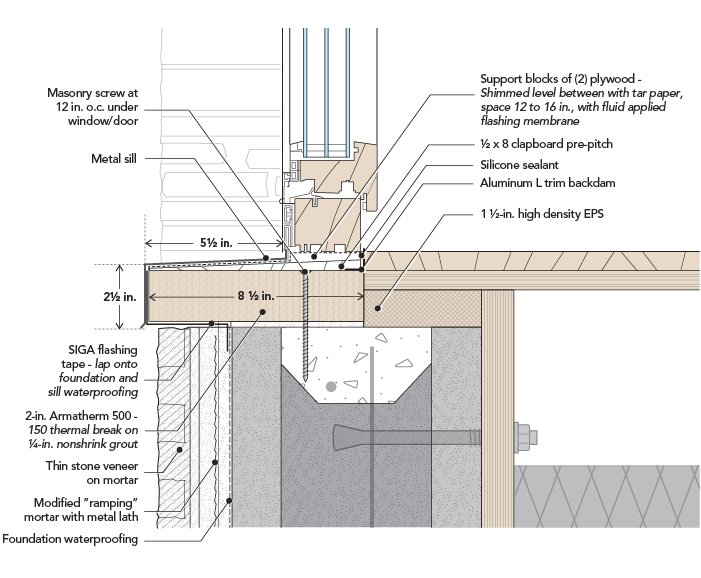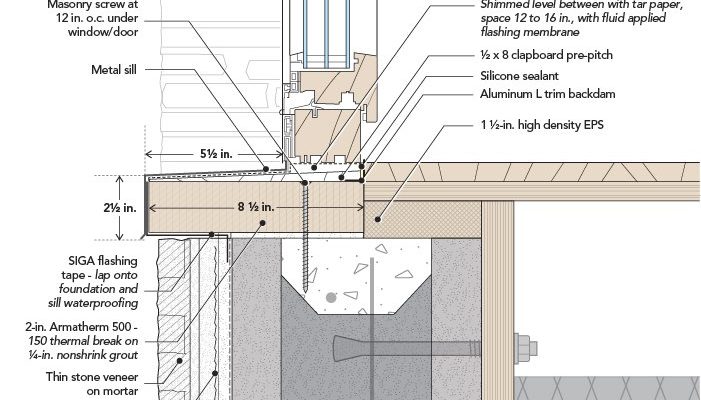
A thermal break threshold adds a layer of insulation at your doorway, stopping heat or cold from sneaking through the bottom of your door. Some brands, like Pemko, sell thermal break thresholds in ready-to-install kits. No high-tech code or programming skills needed—just a few tools, some patience, and a free afternoon. Let’s walk through what makes a thermal break threshold worth installing, how it saves you real money, and how to set one up step-by-step—even if you’re new to weatherproofing or DIY.
What Is a Thermal Break Threshold and Why Should You Care?
Think of a traditional aluminum threshold as a tiny highway for heat and cold—a metal strip that practically invites temperature to pass right through. With a standard threshold, your well-heated (or cooled) air leaks out, and the outdoors slips in, even when your door is fully closed. Now, a *thermal break threshold* interrupts this flow. It usually has a plastic or rubber barrier running through the center, acting like a dam between the inside and outside metal.
Why does this matter? Because that “dam” blocks thermal transfer. In winter, it stops freezing temperatures from sinking into your tile or wood floors; in summer, it keeps the hot air where it belongs. If your threshold isn’t insulated, you’re constantly fighting drafts, condensation, and sometimes even little puddles forming inside when cold air meets warm indoor air.
Honestly, it’s one of those upgrades that doesn’t look dramatic but makes a huge difference over time—especially for energy efficiency. By breaking that path for heat and cold, you help your HVAC system work less, *which means lower energy bills and a more comfortable home*.
How Does a Thermal Break Threshold Save Energy?
You might be wondering: can something as small as a strip under my door really save energy? The answer’s yes, and here’s why. Your home loses heat (or gains it) through any weak spot, and doors are often the worst offender. Even a few millimeters of exposed aluminum can act like a conductor—think of it as a wire for temperature. Every time you run your heater or AC, some of that hard-earned temperature slips away.
A *thermal break threshold* breaks the cycle by inserting a piece of non-conductive material—usually high-density plastic—between two metal sections. This “thermal code” stops energy from syncing between outdoors and in. Instead of being a short circuit for heat or cold, that doorway becomes an energy barrier.
If you have universal remote habits—always looking for the easiest, smartest solution—adding a thermal break is like programming your door for maximum efficiency. Over the course of a year, the energy savings can add up. You might see your utility bill drop, your entryway feel cozier, and your floors avoid the icy touch that comes from old, metal-only thresholds.
Choosing the Right Thermal Break Threshold for Your Door
There are dozens of options for thermal break thresholds, but before you order, take a quick troubleshooting walk around your entryway. Is the current threshold worn out? Is there a big gap under the door, or does cold air creep in even when things seem “sealed”? Measure that gap carefully—most thresholds come in different heights and widths.
Major brands like Pemko, Zero International, and National Guard Products offer both universal models and thresholds made to pair with specific door types (wood, metal, or fiberglass). Some thresholds come as a simple strip you screw in place; others have adjustable heights or built-in weatherstripping for extra insulation. If your door swings out instead of in, make sure to pick a model that’s compatible—installation can differ based on door type.
Tip: If you’re not sure how much space you have, close the door with a piece of paper on the threshold. If the paper slides out easily, you’ll need a thicker model. If it won’t budge, go thinner.
What Tools and Materials Do You Need?
Before you start, let’s talk about what you’ll actually use—no sync, reset, or code programming skills required here, just some basic tools. Here’s a simple checklist:
- Thermal break threshold (cut to the width of your door)
- Tape measure
- Pencil or marker
- Hand saw or hacksaw (if you need to trim the threshold to length)
- Drill with bits (for pilot holes)
- Screwdriver (manual or electric)
- Silicone caulk or adhesive (for creating a weather-tight seal)
- Putty knife (to help remove the old threshold or smooth caulk)
Most kits—especially from Pemko—come with screws and sometimes adhesive strips. If you’re replacing an old threshold, grab a pry bar or sturdy flat-head screwdriver as well. You don’t need advanced skills; if you can pair a remote or replace a battery, you’ve got the right kind of patience and problem-solving for this job.
Removing the Old Threshold Without Damage
Here’s the thing: taking out the old threshold is the trickiest part, but it’s more tedious than technical. Start by opening the door and looking for the screws holding the old threshold in place—usually two or three spread evenly. Grab your screwdriver (or drill), remove the screws, and keep them in case you need spares.
If the threshold is stuck (and many are, thanks to old caulk), use your putty knife to score the edges where the threshold meets the floor. Slip the pry bar under one end and gently lift. Be patient—rushing can crack the flooring or chip the door frame. Work your way along until the whole strip pops free.
Before you start installing the new thermal break threshold, scrape away any leftover caulk, dirt, or debris. A clean surface is key to a tight, weatherproof seal. Don’t skip this step, or your new threshold won’t sit flush, and you’ll end up troubleshooting leaks again.
Installing a Thermal Break Threshold: Step-by-Step
Now for the main event—putting in your new energy-saving doorway bridge. Here’s how to go about it:
- Measure twice, cut once: Set the new threshold in place and see if it fits. If it’s too long, mark the excess with a pencil and cut with a hacksaw. Give yourself a tiny bit of wiggle room at each end—just a millimeter or two—so it seats easily.
- Dry-fit the threshold: With the door open, lay the threshold in place and close the door to check the seal. The rubber or plastic portion should line up with the bottom edge of the door, not squish or leave a gap. Adjust as needed.
- Mark and drill: Use a pencil to mark where the pre-drilled holes in the threshold line up on your subfloor. Remove the threshold, then drill pilot holes at each mark—this will help the screws go in straight and keep the material from splitting.
- Apply caulk: Run a bead of silicone caulk along the bottom of the threshold. This seals out water, bugs, and drafts. Set the threshold in place, line it up carefully, and press down gently.
- Screw it down: Insert the provided screws and tighten until snug. Don’t overtighten—you could crack the threshold or warp the metal. Wipe away any excess caulk that squeezes out.
That’s it! Let the caulk cure (follow the instructions on the tube—usually a few hours), and your entryway should now be energy efficient and draft-free.
Troubleshooting Common Installation Problems
Even if you follow every step, stuff can still go sideways. Maybe your door won’t close after installation, or there’s still a draft. Here’s how to handle a few classic problems:
- Door rubs on the threshold: If your door feels stiff or won’t close, check that the threshold isn’t too tall. You might need to sand down the high spots or adjust the door hinges slightly.
- Still feeling drafts: Double-check that the caulk has filled all gaps and that the threshold sits flush. Sometimes an uneven floor needs a thicker bead of caulk or a shim under the threshold to seal things up tight.
- Condensation or leaks: If water is still sneaking in, pay attention to the ends of the threshold where it meets the door jamb. Adding a dab of caulk here can close up micro-gaps.
If you’re at your wit’s end, remember: Even pros need to reset and try again sometimes. Don’t be afraid to unscrew, realign, and retest. The extra effort up front means years of savings and comfort.
Comparing Thermal Break Thresholds to Other Energy-Efficient Upgrades
Let me explain how a thermal break threshold stacks up to other weatherproofing fixes. Door sweeps, draft stoppers, and heavy rugs can all help, but they don’t address the core problem: temperature transferring through the metal threshold itself. It’s like using a universal remote that doesn’t quite pair with your TV—you get some improvement, but never full control.
A thermal break threshold isn’t the only line of defense, but it has a few unique advantages:
- Permanent fix: Once installed, it works 24/7 without any maintenance or adjustment.
- Invisibly efficient: It doesn’t change how your door looks, so you keep curb appeal.
- Works with other upgrades: You can still use door sweeps or weatherstripping alongside it for even more protection.
If you’re serious about energy efficiency, this is the kind of upgrade that quietly pays off year after year—no reprogramming, no batteries, just a smarter home.
Making Sense of the Investment: Is a Thermal Break Threshold Worth It?
Honestly, if your energy bills are creeping up or you’re tired of dealing with cold toes by the front door, the answer is yes. While a thermal break threshold might cost a little more than a standard strip at the hardware store, the savings add up. Most homeowners see a payback within a couple of winters, just from lower heating costs.
Here’s why it’s smart: Energy efficiency isn’t just about comfort—it raises your home’s value and makes daily life better. That thermal break turns a weak spot into a strong point, stopping leaks before they start. And with brands like Pemko offering reliable, easy-to-install options, it’s a project that fits into a Saturday but pays off for years.
Wrapping Up: Enjoying the Benefits of a Thermal Break Threshold
Swapping out your old entry threshold for a thermal break model might not feel flashy, but you’ll notice the results every time you walk inside. Your home holds its temperature better, your floors stay comfortable, and your energy bills breathe a sigh of relief. It’s a classic “small change, big impact” upgrade—like setting up your favorite universal remote once and having it work every time.
If you’re ready to ditch drafts and make your home more efficient, installing a thermal break threshold is a step in the right direction. Take your time, follow the steps, and enjoy the comfort and savings all year round.
